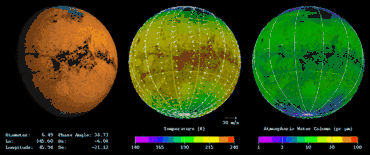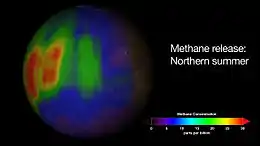Mars general circulation model
The Mars general circulation model (MGCM) is the result of a research project by NASA to understand the nature of the general circulation of the atmosphere of Mars, how that circulation is driven and how it affects the climate of Mars in the long term.

History
Mars climate simulation models date as far back as the Viking missions to Mars. Most Mars climate simulation models were written by individual researchers that were never reused or open-sourced. By the 1990s the need for a unified model codebase came into being, due to the general impact of the internet on climate modelling and research. This current Mars climate simulation model has its origins with the internet era.
How it works
This Mars climate model is a complex 3-dimensional (height, latitude, longitude) model, which represents the processes of atmospheric heating by gases and ground-air heat transfer, as well as large-scale atmospheric motions.[1]
The current model has not been modified for use with distributed computing systems like BOINC.
Methane on Mars


The Martian atmosphere contains 10 nmol/mol methane (CH4).[2] In 2014, NASA reported that the Curiosity rover detected a tenfold increase ('spike') in methane in the atmosphere around it in late 2013 and early 2014. Four measurements taken over two months in this period averaged 7.2 ppb, implying that Mars is episodically producing or releasing methane from an unknown source.[3] Before and after that, readings averaged around one-tenth that level.[4][5][3] On 7 June 2018, NASA announced a cyclical seasonal variation in the background level of atmospheric methane.[6][7][8]
The principal candidates for the origin of Mars' methane include non-biological processes such as water-rock reactions, radiolysis of water, and pyrite formation, all of which produce H2 that could then generate methane and other hydrocarbons via Fischer–Tropsch synthesis with CO and CO2.[9] It has also been shown that methane could be produced by a process involving water, carbon dioxide, and the mineral olivine, which is known to be common on Mars.[10]
Living microorganisms, such as methanogens, are another possible source, but no evidence for the presence of such organisms has been found on Mars.[11][12][13]
Other planets
There are global climate simulation models that have been written for Jupiter, Saturn, Neptune and Venus.[14]
References
- "Mars General Circulation Model – Research". NASA. Archived from the original on 2007-02-10. Retrieved 2007-02-25.
- ESA Press release. "Mars Express confirms methane in the Martian atmosphere". ESA. Archived from the original on 24 February 2006. Retrieved March 17, 2006.
- Webster, C. R.; Mahaffy, P. R.; Atreya, S. K.; Flesch, G. J.; Mischna, M. A.; Meslin, P.-Y.; Farley, K. A.; Conrad, P. G.; Christensen, L. E. (2015-01-23). "Mars methane detection and variability at Gale crater" (PDF). Science. 347 (6220): 415–417. Bibcode:2015Sci...347..415W. doi:10.1126/science.1261713. ISSN 0036-8075. PMID 25515120.
- Webster, Guy; Neal-Jones, Nancy; Brown, Dwayne (16 December 2014). "NASA Rover Finds Active and Ancient Organic Chemistry on Mars". NASA. Retrieved 16 December 2014.
- Chang, Kenneth (16 December 2014). "'A Great Moment': Rover Finds Clue That Mars May Harbor Life". The New York Times. Retrieved 16 December 2014.
- Chang, Kenneth (7 June 2018). "Life on Mars? Rover's Latest Discovery Puts It 'On the Table' - The identification of organic molecules in rocks on the red planet does not necessarily point to life there, past or present, but does indicate that some of the building blocks were present". The New York Times. Retrieved 8 June 2018.
- Webster, Christopher R.; et al. (8 June 2018). "Background levels of methane in Mars' atmosphere show strong seasonal variations". Science. 360 (6393): 1093–1096. Bibcode:2018Sci...360.1093W. doi:10.1126/science.aaq0131. PMID 29880682. Retrieved 8 June 2018.
- Eigenbrode, Jennifer L.; et al. (8 June 2018). "Organic matter preserved in 3-billion-year-old mudstones at Gale crater, Mars". Science. 360 (6393): 1096–1101. Bibcode:2018Sci...360.1096E. doi:10.1126/science.aas9185. PMID 29880683. Retrieved 8 June 2018.
- Mumma, Michael; et al. (2010). "The Astrobiology of Mars: Methane and Other Candinate Biomarker Gases, and Related Interdisciplinary Studies on Earth and Mars" (PDF). Astrobiology Science Conference 2010. Astrophysics Data System. Greenbelt, MD: Goddard Space Flight Center. Retrieved 24 July 2010.
- Oze, C.; Sharma, M. (2005). "Have olivine, will gas: Serpentinization and the abiogenic production of methane on Mars". Geophys. Res. Lett. 32 (10): L10203. Bibcode:2005GeoRL..3210203O. doi:10.1029/2005GL022691.
- Oze, Christopher; Jones, Camille; Goldsmith, Jonas I.; Rosenbauer, Robert J. (7 June 2012). "Differentiating biotic from abiotic methane genesis in hydrothermally active planetary surfaces". PNAS. 109 (25): 9750–9754. Bibcode:2012PNAS..109.9750O. doi:10.1073/pnas.1205223109. PMC 3382529. PMID 22679287.
- Staff (25 June 2012). "Mars Life Could Leave Traces in Red Planet's Air: Study". Space.com. Retrieved 27 June 2012.
- Krasnopolsky, Vladimir A.; Maillard, Jean Pierre; Owen, Tobias C. (December 2004). "Detection of methane in the martian atmosphere: evidence for life?". Icarus. 172 (2): 537–547. Bibcode:2004Icar..172..537K. doi:10.1016/j.icarus.2004.07.004.
- http://www.gps.caltech.edu/~tapio/animations.html
